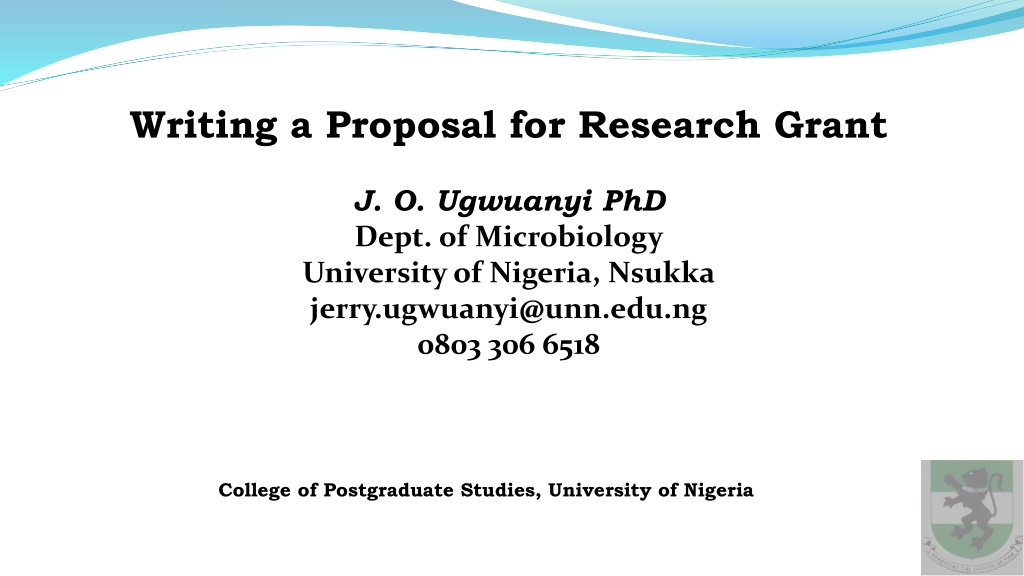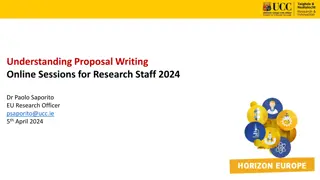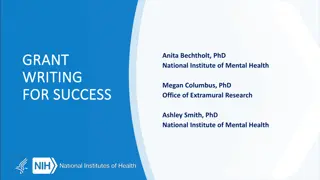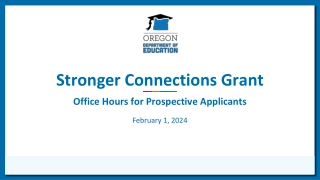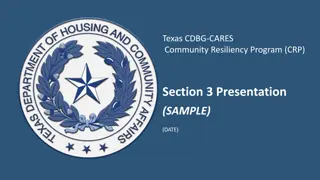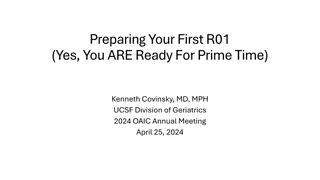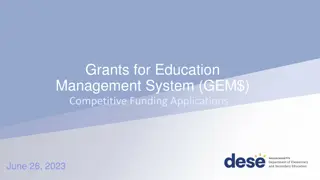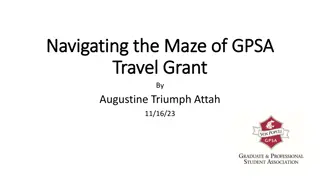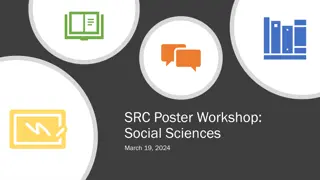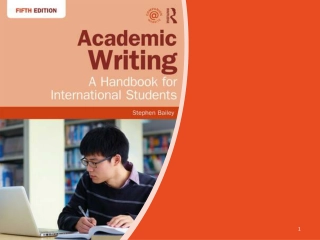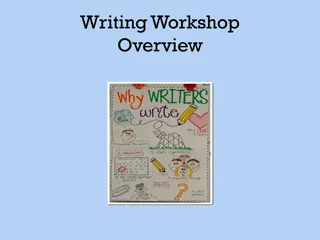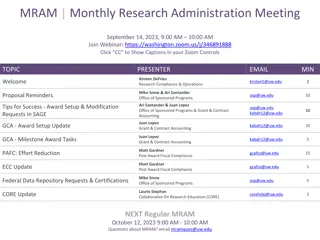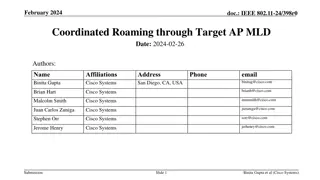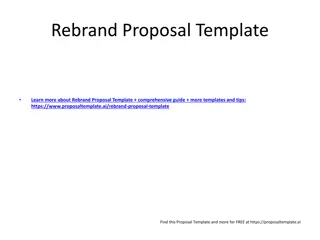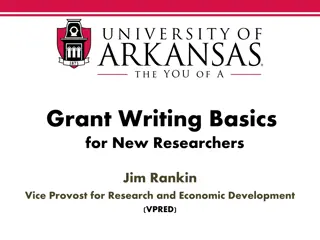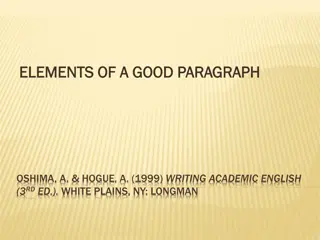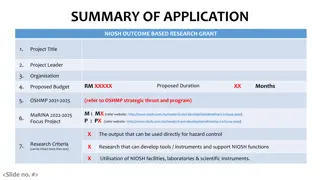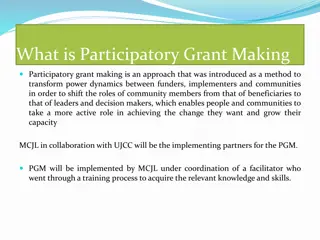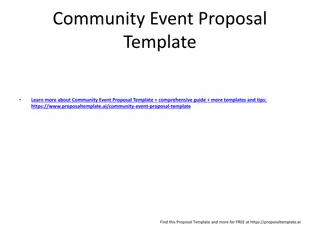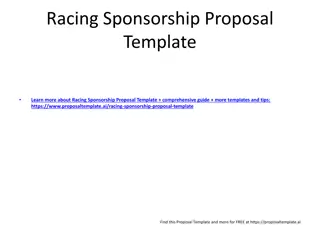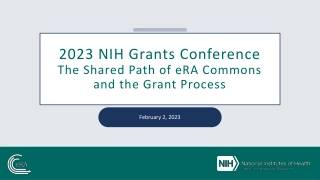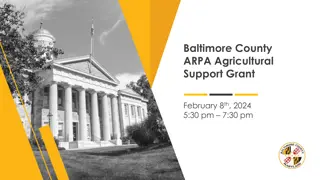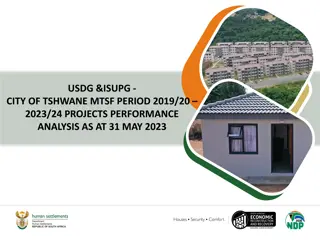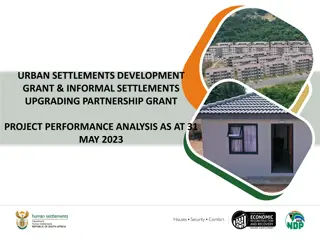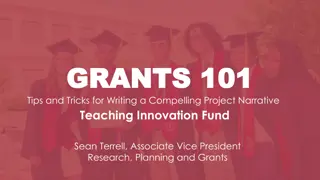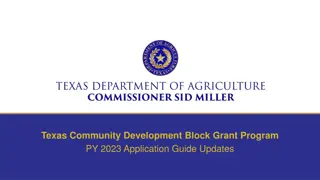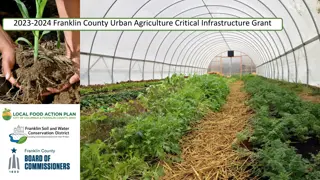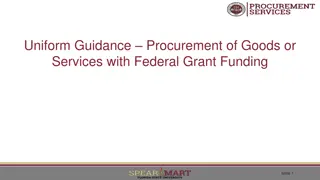Mastering the Art of Grant Proposal Writing
A comprehensive guide to understanding, structuring, and developing successful grant proposals to secure funding for research projects. Learn the essential components, mindset of funders, and key strategies for crafting competitive proposals.
Download Presentation
Please find below an Image/Link to download the presentation.
The content on the website is provided AS IS for your information and personal use only. It may not be sold, licensed, or shared on other websites without obtaining consent from the author. Download presentation by click this link. If you encounter any issues during the download, it is possible that the publisher has removed the file from their server.
Presentation Transcript
Writing a Proposal for Research Grant J. O. Ugwuanyi PhD Dept. of Microbiology University of Nigeria, Nsukka jerry.ugwuanyi@unn.edu.ng 0803 306 6518 College of Postgraduate Studies, University of Nigeria
OUTLINE INTRODUCTION (to grant making process) What is Grant Making About? The Nature of Grant Makers/ Foundations WHAT IS A GRANT PROPOSAL? COMPONENTS OF A PROPOSAL Title Guides to a good title Executive Summary Statement of Problems (Background to the Project) Project Objectives Methods (Methods & Materials; Methodologies etc.) Budgeting Other matters Gantt chart Evaluation Dissemination Sustainability
GOALS & OBJECTIVES of MODULE Appreciate the Nature of Grants Proposals Understand the Basic Needs / Mindset of Funders Understand the General Structure of Proposals Appreciate Key Requirements for a Competitive Proposal Achieve Improved Competency in Proposal Writing Hopefully, Be encouraged to see Proposal Writing as an Interesting Prospect
Introduction: What is a Grant Proposal? A proposal is a codified description of an intended project or program. It is an outline that describes -the values & timeliness, aim, procedures, expected outcomes, costs, time-lines of a solution set. The value to be added through a project must be obvious from the proposal: - i.e., It should be SMART to pass first screen Specific; Measurable; Attainable (Achievable); Realistic; Timely (& time-bound). 4
Reasons for Writing a Proposal As a budget! -To secure funding (GRANT) For Higher Research- Masters, Doctoral, Postdoctoral or Institutional For Employment (Measuring Responsibility & Accountability) For Institutional Reviews Proposals are written in future tense
Funders Mindset An excellent proposal may not be funded if it does not accord with a funder s short, medium or long term interest! The best proposal may not receive funding if the proposer is not known; You must show that you are competent (track record of some sort!!) A very good proposal may not be funded if: somebody has requested to do same or better for less (project economics) a good question was asked badly (conceptualization) a good concept was poorly marketed (presentation/ communication) Grant makers seek to fill a gap between what is & what ought to be - (Funder s world view (not researcher s world view) attempt to understand the funder s world-view on the issue & express it convincingly attempt to reflect the "priorities" of the funder IF THERE IS A CONFLICT, THE FUNDER SHOULD WIN
A good proposal? Opening Questions What is it that I want to do or study? What does this project hope to accomplish? (How you want to change the world) What problem(s) do I want to solve? Is there a problem? Is it important? To who? Do project personnel (I) have the necessary expertise to accomplish the goals? (How does the reviewer know? If not, what should I do?) Will the result achieve funder objectives? Is the project (outcome) cost effective? How good is the fund management plan? Do I come across as frugal, prudent? Have I provided fund management guarantees? (Bear in mind that the funder knows the costs!) Are the evaluation, dissemination & sustainability plans convincing? Now you have asked all the questions (the answers are .positive?)
Main Components of a Proposal Proposals have three main component What is to be done? Why it should be done? No matter the call structures How it will be done? In between there could be several derivative, questions and issues that may include: What is known? Who will do what? When? For how much? What are the evaluation mechanisms? What are the dissemination mechanisms? What is the sustainability plan? 8
Proposal Title The title is your first Abstract! Make sure it tells the story completely This is compelling; to ensure first reading of what you have to say: (compare ) Funders may not give guides for titles: Ensure your title is clear, unambiguous? Avoid any word that does not improve communication Titles should define the thrust of the project and be crisp Ensure single sentence titles. If it is difficult, use colon and semi-colon as last resort. 9
e.g., ?? A multi-year field evaluation of the effects of development of new oil fields on mangrove forests in seasonal and permanent swamps in Nigeria s Niger Delta A 3-year study of the impact of new oil fields on mangrove regeneration and survival in Nigeria s Niger Delta swamps VS ?? Evaluation of fishery potential of Anambra basin of Nigeria Full-year In-stream evaluation of fresh water fish population dynamics in Obina River in the Anambra Basin of Nigeria If the title is not specific/ attractive/ crisp you have already made a bad first impression: If you are in doubt please have somebody read it!
Executive Summary Funder may require an Executive Summary /Overview It is an expanded (often 1 Page/600 wd) Summary of the entire Proposal the person shortlisting may have only enough time to read this- not the entire proposal. So, be sure to pay attention: specific / concise. Do not go into details that are clarified at a later point in your proposal but draw attention to all critical matters. Project Overview should "paint a picture" of the proposal in the mind of a reader. It should establish the framework around which the rest of the write-up revolves. It will help if the Key concerns of the funding organization can be briefly identified in relation to your proposed project. 11
Executive Summary contd. The best time to prepare the Project Overview is after completing the proposal and you understand the story. Pull the most significant sentences from each key section in the grant narrative and do a quick copy & paste with reference to: Project initiative Problem statement/statement of need Research goals Measurable objectives Work-plan/project duration Impact on problem + A mention of the funding requirement The Executive Summary should provide answers to all critical proposal questions or enough reasons for assessor to believe that the answers exist in the body of the proposal. 12
Overview / Executive Summary The Executive Summary is the place to impress the reviewer. Ensure that you can avoid giving the reviewer an opportunity to say things like: Not an original idea Rationale is weak Writing is vague Uncertain outcomes Does not have relevant experience Rejection! Problem is not important Proposal is unfocused Project is too large/ expensive 13
Statement of Problem Why does this research need to be conducted and the problems to be addressed The first steps in deciding this question are: What is known about the question I want to address? Key and cutting edge literature What are the gaps in knowledge that I want to fill? Are these gaps /the presentation of the gaps compelling enough to deserve funding? How will filling the gaps improve the final picture (benefit to clientele): value addition; knowledge, wealth creation, peace, gender, environment, trans-disciplinary & collaboration, (if funding is external emphasise North-South Cooperation) etc.? Novelty? Is the answer you seek to provide already in the public domain anywhere? Always emphasise what is new about your work!
Matter of Novelty vs Innovation In deciding on the novelty vs innovation of what you propose, how do you situate your proposal An entirely new idea? Solution to new/ old problem? A better solution to a well known problem? Cheaper, faster, eco-friendly procedure, gender sensitive, politically correct, etc.? A trans-disciplinary procedure with new better insight and greater sustainability?
Statement of Problems contd. Review relevant Literature. Show the funders that you know what you are proposing; you are familiar with what has preceded you. If you worked in this area and have result be careful to show that without sounding redundant: -Is the project expanding on some preliminary results? Be careful in use of language. It can be very helpful to have somebody who is not familiar with the proposal to read it and minimize use of: Jargon; trendy or "in" words; abbreviations; colloquial expressions; redundant phrases; confusing language Position your project in relation to other efforts and show how your project: a) will extend the work that has been done, b) will avoid the errors that have been previously made, c) will serve to develop stronger collaboration between existing initiatives, or c) is novel or unique or add new value. 16
Statement of Problems contd. Show that your project is needed and should be funded (timely for the problem). Connect your project to theme of call or peculiar interest of the funders Is there a special reason why you and/or your organization are uniquely suited to conduct the project? Geographic location, language expertise, prior involvements, special competence, close relationship to the project clientele, etc. Have you worked with your collaborators before? If not what is the guarantee that the collaboration will work (MOU? Personal Knowledge? Expertise? Commitment?) This is the marketing section of a solicitation or Grant document 17
Summary of Problem statement Your statement of problem---represents the reason behind your proposal. It specifies the conditions you wish to change. It should be supported by evidence drawn from experience, authoritative statistics & cutting edge literature. It should summarize the problems, show your familiarity with prior work on the topic, reinforce your credibility, and justify why this problem should be investigated. Do not assume that everyone sees the problem as clearly as you do. Even if the problem is obvious, your reviewers want to know how clearly you can state it. You may need to itemize this section 18
Guidance questions Does your problem statement 1. Demonstrate precise understanding of the problem? 2. Clearly convey the focus of your project? 3. Indicate the relationship of your project to a larger set of problems or issues and justify why your particular focus has been chosen? 4. Establish the importance and significance of the problem? 5. Justify why your problem should be of special interest to the sponsor? 6. Demonstrate that the problem is feasible to solve? 7. Make the reviewer want to read further? 8. Indicate how the problem relates to your organizational goals? 9. State the problem and outputs in terms of human needs and societal benefits? 10. Answer sustainability question? Remember: Avoid little is known about...", "there is a lack of information about...", or "no research has dealt with..." These suggest that there is little or no problem 19
Objectives of the Project Try to differentiate between your goal (Aim) & your (Specific) objectives but include both. Goals (Aim) relate to what you hope to accomplish but usually are not very measurable. They create the setting for what you are proposing. Objectives are operational, tell specific things you will be accomplishing in your project, and are very measurable. Objectives will form the basis for the activities of your project and will also serve as the basis for evaluation. Proposal is easier to understand (and the outcomes are clearer) if you describe your objectives in measurable ways. 20
Objectives of Project contd. Ensure that there is considerable overlap between the goals & objectives for your proposal and the goals & objectives of the funder or the advertised theme. Include specific information about the population or clientele (immediate or long term beneficiaries) on which your project is focused. Clarify why it is important for the funder to be concerned about your clientele. Your proposal should clearly indicate how assisting your clientele is in the best interests of the funding organization. 21
e.g., Aim To develop innovative integrated cassava value-addition process as driver of rural transformation. Specific Objectives: Develop rural-suited cassava starch extraction process Develop simultaneous hydrolysis-fermentation technology for cassava utilization Achieve innovative valorization of cassava process waste Train entrepreneurs and research manpower to drive cassava utilization.
Research Outputs and Outcomes Provide the expected outputs and outcomes of the project Ensure that each identified output or outcome is or can be tied to a research activity Link individual outputs to activities identified in the methods sections If outputs are cross-cutting, leave them for last and try to identify the actions that will produce them Individual results need not be identified; blocks of results that create impact should be the target
Project Impact Provide information on the long-term impacts of the project (social, economic and technological benefits, etc.) You are looking at Human population beneficiaries (they do not have to be in the immediate vicinity of project Environmental benefits of the project (it can also go beyond your locale) Technological contribution You are looking at how the world will be different because this work was done
Basic Guides to Objectives AS a general guide, keep it SIMPLE Specific--indicate precisely what you intend to change through your project. Immediate make solving this problem urgent and provide time frame. Measurable- What is the proof of project success? Practical- how is each objective a real solution to a real problem. Logical- indicate how each objective systematically contributes to achieving your overall goal(s). Evaluable- indicate how much change has to occur for the project to be effective (mixable with M). These categories are not mutually exclusive, but ensure that each of your objectives meet at least two or three of these six criteria. 25
General Advice Generally, it pays to present your research goals in visionary terms and your objectives in measurable terms. Use words such as decrease, deliver, develop, establish, improve, increase, produce, enhance, secure, and provide- More so when no wheel is being reinvented nor atom rediscovered
Guidance Questions Does your objectives statement Clearly describe your project objectives, hypotheses, and/or research questions? 2. Present the project's objectives in a lean mass of narrative? 3. Demonstrate that your objectives are important, significant, and timely? 4. Describe the intended (& measurable) outcomes of the project? 5. Present basis for future evaluation of outcomes? (NOT PERISHABLE!) 6. Demonstrate why your project's outcome is appropriate and important to the sponsor? List your specific objectives in no more than one-two sentences each in approximate order of importance & progression. 1. A good objective emphasizes what will be done and when it will be done 27
Theoretical Framework This is tricky for people in the Natural and Applied Sciences. Face it, you assessor may be a Social Scientist! Read! There must be a theoretical basis somewhere to underpin what you claim; or it will be difficult to convince that even when you obtain the result (from your experiment) you seek, it will lead to the answers desired or create the value you hope to Find and provide authoritative theoretical framework. Do not go into details It enables you to situate the impact or outcome of the work in relation to clientele or wider beneficiaries
Methodology/ Materials & Methods Detailed methods Chosen for Each Proposed Activity This section describes project activities, .how the objectives will be accomplished; Specific actions to achieve objectives. To include sequence, flow & interrelationship of activities. Ensure there is a clear link between objectives and methods. Each objective will be addressed /achieved by specific set of actions or methods Emphasise how the method will elicit solutions to identified problem. Are there any innovations or possibilities of innovating? What is new, unique or innovative or different? Is the method standard / tested to make success probable or certain? 29
Methodology/ Materials & Methods contd. Emphasise any method that will uniquely benefit the target- immediate or long- term beneficiaries. Do not forget to include the collaborative relationships your project will develop with other co-operating groups and the value they bring. How will the methods encourage trans-disciplinary collaboration. Disciplines are no longer independent. Wherever possible, make society, gender or environment important! Emphasise the value of the methods for sustainability beyond the life of the project If there is institutional project sustainability plan indicate so & emphasise it Best Way: Re-State or Itemize Objective then Describe the Methods you will apply to achieve them 30
Guidance Questions for Methods If applicable, does your method statement: Why do you choose one methodological approach and not another? What are the major activities for reaching each objective? Who are key project personnel who will carry out each activity? What are the interrelationship among project activities? Are you able to demonstrate innovation and the possibility to innovate? Do you identify project data that will be collected for use in outcome evaluation? 1. 2. 3. 4. 5. 6. If a method is not standard, offer convincing explanation as to why it must be used Funders rarely provide a checklist for this section. So PROVIDE YOUR OWN If you are in doubt . Begin with your objectives . Describe what precise steps you will follow to carry out each obj.. Do not forget to tie the methods to MONEY when you get to Budgeting 31
Never Forget: GANTT Chart Once you have determined the sequence of events, cast the major milestones into a time-task chart. called a GANTT Chart (illustrative project scheduling: -Karol Adamiecki, 1896 & Henry Gantt, 1910) In graphic form, it segments the project into manageable steps (A roadmap) It lets your reviewers know exactly what you will be doing and when. It shows that you are organized and have thought out major project steps. It lets funder know you have done significant planning and are not just proposing on a whim. Finally, the GANTT chart represents a clear, one-page, visual summary of the entire methodology section. If it is not specifically prohibited ensure you include this-- requested or not NOT ALL FUNDERS REQUEST IT; BUT ALL FUNDERS LOOK FOR IT 32
Duration and indicative action plan for implementing the action (project) over the 24 month project plan period Time (Month) 1 2 3 4 5 6 7 8 9 10 11 12 13 14 15 16 17 18 19 20 21 22 23 24 Responsibility Action Activity 1 All Researchers Activity 2 Researchers Activity 3 Researchers Activity 4 Researchers Activity 5 Researchers / mentees /Tech Activity 6 Researchers / mentees /Tech Activity 7 Researchers / mentees /Tech Activity PI with Researchers Activity PI with Researchers Activity Researcher & Tech Activity Researchers Activity Researchers Activity PI with Researchers Activity Researchers Activity Researchers Activity Researchers, Tech+farmer Activity Researchers, Tech +farmer Activity Researchers, Tech +farmer Activity PI with Researchers Activity Researchers Activity Researchers Activity PI with Researchers
Expected Results, Outputs & Project Impact Every Identified Project Activity implemented MUST have an Indicator and produce an Output (measurable) Key Methods Yield Result Major Results MUST produce impact Project Impact relate to the Wider Societal value that the project seeks to create (what the funder wants to address; the big picture) They relate to the value that results will bring
Value Added/ Contribution to Knowledge Potential Publications Major Review on Bioenergy resource potential of Cassava for a green economy? Publications Other??
DISSEMINATION AND PUBLICITY How will you be sharing information about your project? Will your project include a Newsletter; Posters, Fliers etc.? How about a web page in your institutional website? Hosting or participation in workshops and conferences? Publications? Patents? Products? State these as prospective output Training? (without offering sponsorship unless allowed) Mentorship! Mentorship!! Mentorship!!! These will be a good ways to publicly recognize your funders. If you do, invite funder to such activity so they can hear what others think about the investment they have made. PUBLICITY MAY BE ALL THE FUNDER GETS FROM YOUR WORK. TAKE SOME TROUBLE TO ADVERTISE YOUR FUNDER 36
Project Evaluation Evaluation helps you to decide whether or not your project has been successful. Evaluations pinpoint what is happening in your project so you can improve efficiency. Based on evaluation information: you can better allocate resources, improve your services, strengthen your overall project performance Achieve Sustainability Most major funders may point out how they hope to evaluate your project performance 37
Evaluation contd. If evaluation is needed let the process Identify the purpose of your evaluation & the audience to be served Demonstrate that the scope of the evaluation is appropriate to the project Demonstrate the extent to which the process is practical and relevant Describe what information will be needed to complete the evaluation, and the instruments that will be used for its collection If you plan to use a survey or questionnaire, you may want to include a draft in the Appendices to proposal Clearly summarize any reports to be provided to the funding source based on the evaluation, and generally describe their content and timing 38
Sustainability Will the project die as soon as the funding is over? If not, how will it continue and on whose funding?
Money matter.Budgeting Budget is a mathematical rendition of your entire project It is more than just a statement of proposed expenditures It is an alternate way of expressing your project. Programs officers will look at your budget to see how well it fits your proposed activities. Incomplete budgets signal sloppy preparation. Inflated budgets are signals, at best of waste; or at worst of questionable credibility. If you come from corruption endemic area? If in addition you are not known to the funding agency or have not implemented a larger project? If the agency ever queried your organisation? Too low a budget casts doubt, at best on your planning ability; or at worst your capacity. Your budget is as much a credibility statement as your project narrative. Sequence budget items as you would a GANTT chart to indicate activity and period of project associated with given cost. Can the funding be phased? It convinces funder about your commitment; can funder do procurement? 40
Money matter.Budgeting If you are a first timer or you are not sure .. Talk to somebody! Make your budget realistic. Ask for exactly what you will need from the funder. (Remember: funding agencies are more experienced in funding than researchers!) Consider organizing your budget around a set of meaningful fundable categories such as: Personnel (salary/ benefits), fringe benefits, dues, Consultants (salary)- accountant, legal service, Instruction, Tuition (if not prohibited) Provide researched estimate for any request and never leave room for doubts Equipment, maintenance, insurance, Consummables Supplies, periodicals, books, research animals Communication (telephone/postage/ internet) Materials preparation, computer time, Services, binding, audio visual, radio, television, advertising Travel, Rental of facilities, transport Evaluation, Dissemination, publication, Other expenses- hospitality, (clearly specify this & never use Miscellaneous) Indirect or Administrative costs (Retained by institution, usually as a per cent of total) 41
Budget Some Important questions Does your budget address these question? Provide sufficient resources to carry out your project? Include a budget narrative that justifies major budget categories? Present the budget in the format desired by the funder? Separate direct costs from indirect costs and describe what is covered in the latter? Relate budget items to project objectives? Did you mention cost sharing, matching grant or sustainability support? Is your organisation contributing? - cash or kind? 42
Sundry Issues Staff/Administration Use this section to describe the roles and value of the different people associated with your project and the importance of each. Make sure you include name, title, experience, and qualifications. Include other information if you feel it is important to the success of your project. Convince the funding agency that you have excellent / competent people who are committed to the project. You are not asking the funding agency to "trust" you. The validity of what you are proposing is directly related to the people who will work on the project. Working together as a part of a team is something that funding agencies often like to see. Make your project a team effort. 43
Sundry Issues Available Resources/ Facilities Collaborative efforts are usually considered very favourably! Many funding agencies like to see cooperative ventures as the basis for action. Some local resources go unnoticed. Look carefully around you because there are resources that you have available but may not be noticing (in-kind resources, volunteers, local competencies meeting rooms, library space, etc.). In-kind resources show a potential funders that you are strongly rooted. Support letters from local resources supporting the project are an excellent. Be careful in listing the equipment that will be needed for your project. Funding sources are often more willing to provide funds for the support of personnel than they are to support the purchase of equipment. 44
Concept Note What is this? i. Title of Proposed Research ii. Background to the Research iii. Statement of the Problem iv. Objectives of the Research v. Research Questions ??? vi. Literature Review vii. Research Methodology viii. Expected Results ix. Innovation x. Total Estimated budget xi. Reference List of Team Members Concept Note is Usually Size-Limited. Never Exceed it!
SOME KEY GRANTING AGENCIES- HAVE A LOOK AT GRANTS REGISTER and Be a Friend of the Internet United States Agency for International Development (USAID) www.usaid.gov British Council www.britishcouncil.org Bill &Melinda Gates Foundation www.gatesfoundation.org Korea International Cooperation Agency (KOICA) www.koica.go.kr Japan International Cooperation Agency (JICA) www.jica.go.jp Japan Bank for International Cooperation (JBIC) www.jbic.go.jp Foreign and Common wealth Office www.gov.uk/government/organisations/foreigncommonwealth-office Swedish International Development Cooperation Agency (SIDA) www.saida.se AGRITECH www.agritechgroup.com Danish International Development Agency (DANIDA) www.um.dk>danida-en International Development Research Centre (IDRC) www.idrc.ca Department for International Development (DFID) www.gov.uk/government/organis ations/departemnt-forinternational-development
European Union (EU) www.europa.eu World Bank www.worldbank.org Norwegian Agency for Development Cooperation (NORAD) www.norad.no/en/front/ UNICEF www.unicef.org French Development Agency (AFD) www.afd.fr/en The International Fund for Agricultural Development (IFAD) www.ifad.org Rockefeller Foundation www.rockefellerfoundation.org Australian Aid (AusAid) www.dfat.gov.au/aid/Pages/australiasaid-program.aspx New Zealand Aid (NZAid) www.mfat.govt.nz/en/aid-anddevelopment/ Carnegie Foundation www.carnegiefoundation.org International Foundation for Science www.ifs.se WellcomeTrust www.wellcome.ac.uk Innovate UK www.gov.uk/government/organisation s/innovate-uk National Institutes of Health (NIH) www.nih.gov The International Food Policy Research Institute www.ifpri.org Centre for Disease Control (CDC) www.cdc.gov United Kingdom Aid (UKAid) www.ukaiddirect.org The Association of Commonwealth Universities (ACU) www.acu.ac.uk Medical Research Council (MRC www.mrc.ukri.org Ford Foundation www.fordfoundation.org EDCTP www.edctp.org European Commission (EC) www.ec.europa.eu Alexander Von Humboldt Foundation www.humboldtfoundation.de/web/home.ht ml
